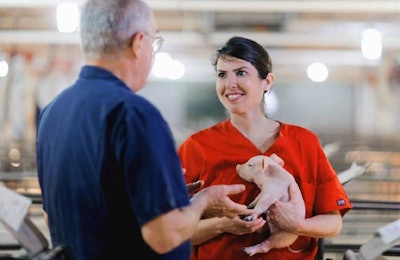
The number of businesses active in the food industry with a commitment to animal welfare continues to grow, not only in developed economies but also in developing markets.
But what is driving this change?
According to discussions with the participants in the Business Benchmark on Farm Animal Welfare (BBFAW) – an assessment of companies' practice and reporting on farm animal welfare supported by Compassion in World Farming, World Animal Protection and investment firm Coller Capital -- there is a recognition that farm animal welfare is a business risk that needs to be managed in a similar way to other business risks, and this is leading companies to integrate welfare into their management infrastructures.
Additionally, farm animal welfare is seen as a strategic opportunity both in terms of the potential for new product offerings and market access, and in terms of brand differentiation and reputation enhancement.
The questions remains, however, what is creating these risks and opportunities? Most companies believe it is pressure from customers and clients, according to the results of a recent BBFAW survey.
Seventy-eight percent of respondents reported that customer and client interest was the most important influence on their approach to welfare. Media interest was cited by 49 percent, while non-government organization and investor pressure were cited by 46 percent.
According to Dr. Rory Sullivan, expert advisor to the BBFAW, pressure from these groups has moved farm animal welfare from the farm gates to the boardroom and, increasingly, companies see it as a core risk and strategic issue, featuring alongside such issues as climate change, water and public health.
Broader penetration
The latest edition of the BBFAW shows that the importance given to welfare is spreading across sectors of the food economy.
While retailers continue to dominate the ranking’s top tiers, the greatest improvements in overall performance over the last year have been in foodservice, closing the gap that previously existed between it and retailers and wholesalers and producers and manufacturers.
This is perhaps illustrated by the example of U.K. pub and hotel chain JD Wetherspoon PLC, which first appeared in the benchmark in 2016 at Tier 6, but last year shot up to Tier 3.
The company’s director of audit, James Ullman, notes that welfare is an integral part of maintaining the business. Ranking at Tier 6 presented the company with both challenges and opportunities, he notes, adding that the company’s challenge now is to keep moving upwards and to bring about positive change.
Challenge of artificial meat
But beyond customer, client and consumer pressure and ever-greater moves towards transparency, there may be other reasons why businesses in the animal protein sector need to improve their animal welfare practices and ensure that these practices are thoroughly communicated.
Speaking at the launch of the latest edition of the BBFAW, Steve McIvor World Animal Protection chief executive, said: “Livestock production practices that meet animal welfare requirements are necessary to maintain consumer confidence, and with growing interest and investment into non-meat alternatives by major players in the food industry, the challenge for meat and dairy producers is to build better welfare into sustainable, efficient livestock systems.”
Businesses that still view good animal welfare as simply “nice to have,” rather than core, or that pay little heed to it at all, may want to take note of what McIvor says.
Should laboratory-grown or artificial meat will become cheap enough to reach the mass market, it will be a product around which there will be no welfare discussion, and this could present even greater pressure for animal protein producers than any encouragement to improve welfare that might be felt now.


















